Facsimile or Forgery?
An
Examination of America, Plates 4 and
9, Copy B
Joseph Viscomi *
In 1927 the copy of Blake’s America we now know as copy L was sold
as a “facsimile reprint” for £4, though it is quite genuine. [1] It is not unheard of for
an
original work of art to be sold as a facsimile, but it is certainly more common
for a facsimile to be sold as an original. The authenticity of plates 4 and 9
of America copy B, in the Pierpont Morgan Library, has never been doubted
in print. But in fact neither one is an original impression. Although both are
facsimiles photomechanically reproduced on wove paper, very little about either
image appears suspicious. Indeed, both are reproduced in The Blake Collection of Mrs. Landon K. Thorne. [2] The true technical and historical origins of plates 4
and 9 are not easily identified. What information we have is supplied only from
the plate measurements and foliation, the binding, and the inscription on the
front flyleaf of copy B. From these few facts, and with much caution, we can
begin to speculate about who executed the plates, when, how, and why.
Plate Measurements
Plates
4 and 9 (illus. 1, 2) are printed on the same paper, the feel, weight, and
texture of which are, from the verso, noticeably different from the other
sheets in the book. The paper—which called to mind Murillo, an etching paper
I
had printed on before—and not the image, made me suspicious enough to check
some measurements. [3] A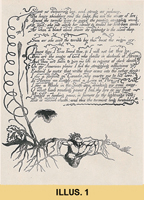
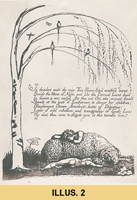 s in most copies of America, the last four lines of plate
4 have been masked out. Unlike all other copies, however, the bottom platemark
is
only 2.4 cm. from Orc’s foot, instead of the usual 4.1 cm. If this bottom
platemark were caused by the material used to mask out the four lines, then,
because 2.4 cm. is not wide enough, half of line 3 and all of line 4 would have
printed. If this were the platemark of an authentic impression, then Blake’s
plate had been cut in about the middle of the third line, a possibility not yet
to be ruled out since the plate could have been pulled posthumously and there
is precedent for such plate tampering. [4] To make sure
I was not looking at a late impression or posthumous pull, I also checked the
distance
in
plate 4 from the top platemark to Orc’s toe: 19.5 cm. in copies A and L, but
20.4 cm. in copy B. In plate 9, the distance from the top platemark to the
first line is 11.6 cm. in copy L, but 12.0 cm. in copy B; from the bottom of
the text to the
bottom platemark is 8.4 cm. in copies A and L, but 9.15 cm. in copy B. Because
the relation of image to platemark did not check out, I measured the distance
between parts within the image. For example, line 4 of plate 4 is 12.6 cm. long
in copies A and L, but 13.0 cm. in copy B. Line 7 of plate 9 is 11.5 cm. long
in copies A and L, but 11.9 in copy B. [5] More revealing than
incorrect measurements within the image and between image and platemarks,
however, are the plate measurements themselves. Plate 4 of copy B is 22.9 x
16.9 cm. vs. 23.8 x 16.6 cm., and plate 9 of copy B is 24.9 x 17.5 cm. vs. 23.5
x 16.8 cm. [6] These and other differences
are too great to have been the result of one paper shrinking less than the
others. Damp printing paper shrinks only 1 to 2.5 % of the sheet size, [7] which could not, for example,
account for the 1.4 cm. difference between the length of plate 9 of copy B
(24.9 cm.) and of copy A (23.5 cm.).
s in most copies of America, the last four lines of plate
4 have been masked out. Unlike all other copies, however, the bottom platemark
is
only 2.4 cm. from Orc’s foot, instead of the usual 4.1 cm. If this bottom
platemark were caused by the material used to mask out the four lines, then,
because 2.4 cm. is not wide enough, half of line 3 and all of line 4 would have
printed. If this were the platemark of an authentic impression, then Blake’s
plate had been cut in about the middle of the third line, a possibility not yet
to be ruled out since the plate could have been pulled posthumously and there
is precedent for such plate tampering. [4] To make sure
I was not looking at a late impression or posthumous pull, I also checked the
distance
in
plate 4 from the top platemark to Orc’s toe: 19.5 cm. in copies A and L, but
20.4 cm. in copy B. In plate 9, the distance from the top platemark to the
first line is 11.6 cm. in copy L, but 12.0 cm. in copy B; from the bottom of
the text to the
bottom platemark is 8.4 cm. in copies A and L, but 9.15 cm. in copy B. Because
the relation of image to platemark did not check out, I measured the distance
between parts within the image. For example, line 4 of plate 4 is 12.6 cm. long
in copies A and L, but 13.0 cm. in copy B. Line 7 of plate 9 is 11.5 cm. long
in copies A and L, but 11.9 in copy B. [5] More revealing than
incorrect measurements within the image and between image and platemarks,
however, are the plate measurements themselves. Plate 4 of copy B is 22.9 x
16.9 cm. vs. 23.8 x 16.6 cm., and plate 9 of copy B is 24.9 x 17.5 cm. vs. 23.5
x 16.8 cm. [6] These and other differences
are too great to have been the result of one paper shrinking less than the
others. Damp printing paper shrinks only 1 to 2.5 % of the sheet size, [7] which could not, for example,
account for the 1.4 cm. difference between the length of plate 9 of copy B
(24.9 cm.) and of copy A (23.5 cm.).
Except for the platemarks,
plates 4 and 9 are free of the embossment that is characteristic of a relief
etching, or a process block. Instead, the ink lies flat on the paper, which is
characteristic of lithography. The platemarks are themselves suspicious, as
I’ll explain later, and do not positively identify the kind of lithography
used. But whether these impressions were pulled from stone or metal plates,
whether produced from a transfer or directly from a reverse negative, one thing
is certain: they are photolithographs. The proportion of the parts to each
other is correct, which indicates the work of a camera. But compared to the
originals, the overall dimensions are slightly distorted, or elongated, which
indicates either the slight distortion in the negative caused by the camera
lens or in the contact between the transfer paper and the stone. In any event,
with a photomechanically reproduced image, a good solid black ink (and not the
thinner greyish black of tonal lithography), an impression that has been
touched up in black water color (like the other prints in copy B), and
platemarks, it is little wonder that these two plates have escaped detection.
Plate Numbers
America copy B
was stabbed through two different sets of three holes. Plates 4 and 9, however,
have no stab holes, though both plates are numbered. Copy B has two sets of
numbers: 1-16 and 1-18. Both sets are in pencil and start on plate 1, and
neither set is by Blake or C.H. Tatham, the first owner of copy B. [8] Numbers 1-16 are written
just below the platemark on the left hand side; numbers 1-18 are written at the
top right corner of the leaf. Plates 4 and 9 are the two plates not in the 1-16
sequence, which indicates that 1-16 is the set of numbers first given to the
plates. [9] Plates 4 and 9 are numbered in set II, and just below “4” and “9”
is a “7”. [10] That plates 4 and 9 are not included in the first set of numbers, and
that neither sheet has stab holes, suggest that copy B had for a time only
sixteen plates to number and stitch.
Binding
America was “splendidly bound in Citron morocco” when it sold in 1878 with the
library of A.G. Dew-Smith at Sotheby’s for £16.5 (lot 247) to John Pearson.
According to the Sotheby catalogue, copy B sold in 1874, unbound, for £18.
Being bound by 1878 would seem to imply that the facsimiles were executed
before this date, but this is not necessarily the case, because plates 4 and
9
are not in the binding but are tipped in. They are glued to plates 5 and 10,
are without gilding, and are slightly lower than the rest of the pages,
noticeable only when looking along the foreedge. The facsimiles enter after,
not before, the binding. [11]
The tipping-in of plates 4
and 9 indicates that one of the owners after 1878 could also have been
responsible for their execution and insertion. Three of these owners had access
to facsimilists and to models, and had reason enough to complete an incomplete
copy. John Pearson, the bookseller, published the excellent Jerusalem facsimiles with 100
photolithographs in 1877, and was William Muir’s first agent, issuing four of
Muir’s Blake facsimiles in 1884-85. Bernard Quaritch, who owned the book in
1890, was Muir’s agent in 1885-94, and issued a series of facsimiles by William
Griggs from his own and other collections, including Poetical Sketches (1890) and The
Book of Ahania (1892). He also owned another copy of America (R), which he lent Muir for his 1887
facsimile. Bernard Macgeorge, who owned the copy from 1892 to 1924, also knew
Muir; Macgeorge lent Muir Europe copy
A, which was then missing five plates, and which were “all supplied in
facsimile by Muir.” [12] Macgeorge also owned Songs copy A, which entered the British
Museum in 1927 [13] with photolithographs
of
plates 51, 52, 53, and b.
The Inscription
Before eliminating suspects,
we must examine a pencil inscription on the front flyleaf:
Lowndes [pens?]
18 designs [14]
There are 2 more in some copies
but I believe these to be a supplementary number
& that the book is perfect & is only 18
Assuming “is only 18” refers back to “designs” and
not to £18, the price the 1878 Sotheby catalogue says it sold for in 1874,
the inscription can still be read in one of two ways, depending on whether
“designs” refers to pictures or pages. In the Prospectus, Blake uses the
word
“design” to mean picture, not plate or page. [15] America, minus plates 4 and 9, would
still have eighteen designs if, as Blake himself did with the Marriage, one were to
separately count the top and bottom pictures on two plates as separate designs.
By counting in this way, there would, indeed, be “some copies” with “2 more”
designs, whereas in fact there are no copies with twenty plates. If, on the
other hand, “designs” is referring to pages, then the inscription is referring
to a copy in which the two facsimiles have already been inserted, a copy,
in other words, with eighteen plates. In this second interpretation, the
statement
“There are 2 more in some copies” is probably a reference to Gilchrist’s
description of America as
“a folio of 20 pages.” [16]
The inscription is written
on a flyleaf, thus written after the book is bound. [17] The insertion of plates 4
and 9 also follows the binding, but may precede or follow the inscription.
There are only two possible combinations of these three bibliographical facts:
binding, inscription, insertion, or binding, insertion, inscription. If the
inscription precedes the insertion, the inscription refers to a copy that
still has only sixteen plates. If the inscription succeeds the insertion,
the
inscription refers to a book with eighteen plates. Neither combination rules
out the possibility of the inscription and/or insertion occurring after
1878—unless we can date the inscription.
The Sotheby catalogue entry
for the 29 January 1878 auction and a comparison of the numbers in set II with
those in the inscription make me believe that the inscription followed the
insertion of the plates. The catalogue entry describes copy B as:
. . . presentation copy with
author’s autograph inscription, splendidly bound in Citron morocco, ornamented
with variegated leathers and gold tooling, e.g. by F. Bedford; two leaves said
to be wanting, but Blake’s original prospectus says “America, a prophecy in illuminated printing,
folio, with 18 designs, Lambeth, W. Blake, 1793.” This copy, unbound, sold for £18 in 1874.
The cataloguer’s “two leaves
said to be wanting” seems to refer to the assertion in the inscription that
“There are 2 more in some copies.” If so, the inscription was already written
by 1878. And his “but Blake’s original prospectus says”
clearly implies that two leaves are not wanting, that this copy of America has 18 plates, the
number that the prospectus says it should. The idea that the cataloguer is
counting pages rather than illustrations is supported by internal evidence. As
I mentioned, the two sets of plate-numbering are by different hands, but the
“8” in the inscription—a very distinct δ—is, I believe, the same
“8” in numbers “8” and “18” of the second set of plate-numberings.
If the inscription is
pre-1878 and is written by the same person who renumbered the plates, then
the two facsimiles must have entered America copy B between 1874, when it is reported to have been unbound, and
January 1878, by which time it was bound and in Dew-Smith’s library. Who
bought copy B in 1874 is unknown; it may or may not have been Dew-Smith.
Thus plates 4
and 9 could have been inserted either before or during Dew-Smith’s ownership. [18] In the first case, someone
other than Dew-Smith purchased copy B in 1874, had it bound, inserted plates
4 and 9, and, possibly, even wrote the inscription and renumbered the plates.
In
the second case, Dew-Smith bought the volume either bound with sixteen plates,
or unbound in 1874 and had it bound, only to find out later that it was missing
plates 4 and 9. He had the two plates made, inserted them, and described
his copy as perfect. But it is also possible that Dew-Smith wrote the inscription
and renumbered the pages in good faith, having bought a bound volume with
plates 4 and 9 already inserted.
Reproductive Process Used to
Make Plates 4 and 9
In the 1870s,
photolithographs could be printed from fine-grained limestones and from
specially grained zinc plates. To use stone, the negative of the copy to
be reproduced is placed in contact with paper coated with a light-sensitive
gelatine film. The areas exposed to light become insoluble in water, so that
when the sheet is covered with a transfer ink and soaked in a bath of water,
all the soluble (unexposed) gelatine lifts off the paper, leaving only the
inked image ready to be transferred (counterproofed) onto the prepared stone.
To use zinc plates instead of stone, a reverse negative is exposed directly
on
a sensitized zinc plate, which, because it eliminates the intermediate step
of transferring the image, is “much more likely” to retain “the finer qualities”
of the original. [19] The fine details of plates
4 and 9, including subtle traces of ink along the sides of the text, suggest—as
do the platemarks—that these two
prints were pulled from zinc plates. Lithography is a planographic method
which, at least theoretically, should not leave platemarks. But because a
press and a scraper bar are used, printing with too much pressure and with
a bar
wider than the plate will emboss the shape of the stone or metal plate into
the print. The platemarks on plates 4 and 9 reveal the even edges of a metal
plate,
not the irregular edge of stone. But, as I mentioned, these marks are
suspicious.
Robert N. Essick has in his
collection what are possibly the proofs of plates 4 and 9 (illus 3, 4).
His two impressions were printed on larger sheets (40.3 x 28.5 cm. for
plate
4, and
44.5 x 28.5 cm. for plate 9, vs. 36.3 x 26.1 cm.), on different paper (“thin,
hard, ivory colored, machine made”), [20] 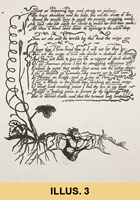
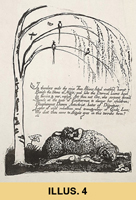 and in a dull black ink.
Neither of his prints has any trace of side platemarks, while the side
platemarks are the ones most noticeable in plates 4 and 9 of copy B. In plate
4, the bottom, top, and left platemarks are sharply defined, while the right
side is slightly beveled. In plate 9, the plate lines forming the two bottom
corners and top right corner intersect; the bottom platemark, for example,
is 18.5 cm. long, while the distance between the platemarks is only 17.5
cm. In
Essick’s plate 9, this bottom platemark is “about 20 cm. long.” [21] This slight crossing of plate lines in copy B and the fact that
the side platemarks are heavier while altogether absent in Essick’s two prints
mean that the side platemarks in plates 4 and 9 of copy B are faked.
and in a dull black ink.
Neither of his prints has any trace of side platemarks, while the side
platemarks are the ones most noticeable in plates 4 and 9 of copy B. In plate
4, the bottom, top, and left platemarks are sharply defined, while the right
side is slightly beveled. In plate 9, the plate lines forming the two bottom
corners and top right corner intersect; the bottom platemark, for example,
is 18.5 cm. long, while the distance between the platemarks is only 17.5
cm. In
Essick’s plate 9, this bottom platemark is “about 20 cm. long.” [21] This slight crossing of plate lines in copy B and the fact that
the side platemarks are heavier while altogether absent in Essick’s two prints
mean that the side platemarks in plates 4 and 9 of copy B are faked.
Such platemarks can be made
with a stylus along a metal ruler with a bevel, or along a metal plate. The
top and bottom platemarks, however, appear to have been produced by a metal
plate
in the process of printing, and they are the same distance from the image
in Essick’s two prints as they are in copy B. Thus, plates 4 and 9 are
either
printed from zinc plates, or the same blank metal plates are registered exactly on both sets of impressions. [22] Pulling a lithograph
face down on a blank metal plate through a rolling press would give platemarks,
but such a trick doesn’t explain why side platemarks are absent in Essick’s
two
prints, or how platemarks can intersect, or why the length of a platemark
from the same plate is different in two impressions. Perhaps plates 4 and
9 were
printed on a litho press using scraper bars of two different sizes, neither
of which was as wide as the plates, and thus not able to force paper over
the
sides, but which came onto and off the plates with enough pressure to catch
the top and bottom edges. The missing side platemarks, therefore, had to
be added
with a stylus. In any event, because lithographs from zinc and stone would
ordinarily have been printed without platemarks, the platemarks, however
they were made, were made to deceive, to make a flat image appear slightly
embossed
like a relief etching. The intention to deceive makes plates 4 and 9 forgeries,
not facsimiles.
The Original
Prints Reproduced
For there to be two photomechanically reproduced forgeries,
two authentic prints must have been photographed. The bottom four lines
of plate 4 (illus. 5) are missing in the fake
impression, which means its model is missing these four
lines, due to Blake having masked them when printing the plate.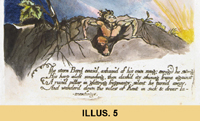 And
because photolithographs of the period could reproduce line drawings or
designs
only in pure black and
white (half-tone screens not yet having been perfected[23]),
the two authentic prints photographed must have been uncolored. In addition
to there being requisites
for the models, both fake prints also have distinguishing, albeit, more
subtle, marks. Plate 4 has an extra line on the lower right side of the
leaf underneath
the text, ink splatters on the right side of the tree, opposite line 8,
and at
the end of the last word, “foretold”; plate 9 is missing the two birds
flying under the lowest tree branch, has an ink trail along the left of
the tree
trunk, a top branch that is lightly extended to the leaves, and ink splatters
along the right side of the plate and along the bottom just under the grass.
And
because photolithographs of the period could reproduce line drawings or
designs
only in pure black and
white (half-tone screens not yet having been perfected[23]),
the two authentic prints photographed must have been uncolored. In addition
to there being requisites
for the models, both fake prints also have distinguishing, albeit, more
subtle, marks. Plate 4 has an extra line on the lower right side of the
leaf underneath
the text, ink splatters on the right side of the tree, opposite line 8,
and at
the end of the last word, “foretold”; plate 9 is missing the two birds
flying under the lowest tree branch, has an ink trail along the left of
the tree
trunk, a top branch that is lightly extended to the leaves, and ink splatters
along the right side of the plate and along the bottom just under the grass.
Of
the seven monochrome copies with a masked plate 4, America (F), in the British Museum since 1859, comes closest to having these
peculiar markings (illus. 6). 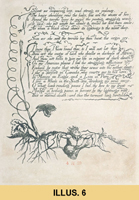
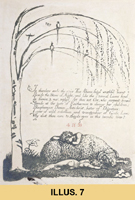 [24] Plate 4 (F) has both sets
of ink splatters and an ink trace that could have been transformed into
an extra leaf line, and the two birds in plate 9 are very faint. On the
other
hand, plate 9 (F) has no ink trail, no completion of the top branch, and
no ink splatters along the right side of the text. But just as the ink
stain at the
bottom of plate 9 (F), the “JY 59” (illus. 7) museum accession number (1859),
and the birds could have been rubbed off the plate so that they wouldn’t
show in an impression, the light marks completing the branch in plate 9
(B) could
have been added, and the ink traces accidentally printed from the litho
plate itself, possibly the result of it not being thoroughly sponged during
inking.
Because an image on stone or zinc could be altered in such subtle ways,
absolute verification may not be possible, but it does seem probable that
plates 4 and 9 of copy F were the prints photographed by or for the forger.
[24] Plate 4 (F) has both sets
of ink splatters and an ink trace that could have been transformed into
an extra leaf line, and the two birds in plate 9 are very faint. On the
other
hand, plate 9 (F) has no ink trail, no completion of the top branch, and
no ink splatters along the right side of the text. But just as the ink
stain at the
bottom of plate 9 (F), the “JY 59” (illus. 7) museum accession number (1859),
and the birds could have been rubbed off the plate so that they wouldn’t
show in an impression, the light marks completing the branch in plate 9
(B) could
have been added, and the ink traces accidentally printed from the litho
plate itself, possibly the result of it not being thoroughly sponged during
inking.
Because an image on stone or zinc could be altered in such subtle ways,
absolute verification may not be possible, but it does seem probable that
plates 4 and 9 of copy F were the prints photographed by or for the forger.
Conclusion
We do not know
for sure who is responsible for executing and inserting the two forgeries into America copy B. The person who
wrote the inscription and renumbered the plates is not necessarily the person
who inserted the two prints. The inscription may be the hand of an honest owner
warding off Gilchrist’s implication that his copy with only “18 designs” was
incomplete. But, according to my reading of the evidence—and other readings may
be possible—we do know when (between 1874 and 1878), how (photolithography),
where (London), the probable model (F), and, I believe, why. Plates 4 and 9 are
not facsimiles; they are not taken from a lost facsimile edition of America made in the 1870s. In short,
they are not like Trianon Press facsimilies doctored up to fool the
unsuspecting eye. Plates 4 and 9 were executed from the beginning with the
intention to pass as originals and thereby secretly complete an otherwise
incomplete copy. The plates have done well at both. Many professional
bibliographers and bibliophiles have examined this copy of America. To
their credit, plates 4 and 9 are not only extremely good forgeries, but,
and I think this is equally important, as pages in a bound volume, they appear
innocent by association. Had plates 4 and 9 been separate prints, it is more
likely they would have been detected long ago. As it is, no other illuminated
book, bound or loose, is known to contain a facsimile. Do we need to look
harder? “Let the collector of prints be cautioned . . . to beware of buying
copies for originals. Most of the works of the capital masters have been
copied, and many of them so well, that if a person be not versed in prints, he
may easily be deceived” (William Gilpin, An
Essay on Prints, 4th ed., 1792).
ILLUSTRATIONS
1. America, copy B, plate 4. Courtesy of the Pierpont Morgan Library,
Thorne Collection.
2. America, copy B, plate 9. Courtesy of the Pierpont Morgan Library,
Thorne Collection.
3. America, plate 3, facsimile. Robert N. Essick Collection.
4. America, plate 9, facsimile. Robert N. Essick Collection.
5. America, copy A, plate 4. Courtesy of the Pierpont Morgan Library,
Thorne Collection.
6. America, copy F, plate 4. British Museum.
7. America, copy F, plate 9. British Museum.
NOTES
[*] Blake/An Illustrated Quarterly 16 (Spring, 1983): 217-223.
[1] G.E. Bentley, Jr., Blake Books (Oxford: Oxford Univ. Press,
1977), p. 104.
[2] G.E. Bentley, Jr. (New
York: Pierpont Morgan Library, 1971), plates IX and XI. America, copy B, was given to the Morgan
Library by Mrs. Thorne in 1973. For the complete provenance of copy B,
see Thorne Catalogue, p. 26, or Blake Books, p. 100.
[3] Thomas Lange, the assistant
curator in charge of books and prints at the Pierpont Morgan Library in 1978, also noticed the difference in paper and suspected the two plates.
Bentley seems to have been a bit puzzled by the difference too, but noted only
that plate 9 was printed on “stiffer paper than the
rest” (Thorne Catalogue, p. 26).
[4] In the posthumous pull
of
“The Little Black Boy” (pl. 9), the woman’s bun was removed and her
back narrowed with a burin. Songs of
Innocence (U) contains such a pull, though it is
recorded as an extra impression (Blake Books, p. 366). See
“Posthumous Pulls in Songs of lnnocence, copy U” (forthcoming).
[5] These and a list of other
measurements concerning plates 4 and 9 of copy B have been
corroborated—and corrected—by Robert N. Essick, who has copies of both
facsimiles in his collection, and who has been most generous in sharing
information. He and G.E. Bentley, Jr. have read early drafts of this paper and
have made valuable suggestions, many of which have been incorporated in this
final version.
[7] Philip Gaskell, A New Introduction to Bibliography (Oxford: Oxford Univ. Press, 1972), p. 13.
[8] On the verso of the
frontispiece is the inscription: “From the author/ C H Tatham Octr 7/1799.” Presumably this is Tatham’s hand; it is not Blake’s. In any case,
the “7” and “9” do not resemble the “7” and “9” in either set of numbers. Blake did number two copies of
America (A and M) 1-16, but he started
on plate 3, not plate 1, and numbered, as was his custom, in the
right hand corner of the plate in ink.
[9] The numbers of set I may
not, however, have been the first attempt at pagination. Numbers 4, 5, 7, and 11 of set I are
written over other numbers, or marks, that were erased; numbers 6
and 8 are very light, and a 7-like mark is written over the 3.
[10] The “7” is the same size (.6 cm.) and in the same position (2 cm.) from the edge of the sheet,
right under the number). In plate 4, the bottom of the number is partly
erased, or smudged. There is a larger smudge mark just under the “7” on plate 9.
This “7” may be a printer’s mark rather than a number.
[11] The pages were trimmed
before insertion. The two leaves are slightly lower at the top, and less so at
the bottom. They appear flush with the fore-edge, but are actually a fraction
lower, noticeable when the fore-edge is riffled In short, plates 4
and 9 were cut and trimmed separate from the other sheets.
[12] A Catalogue of the Library of Bernard Buchanan Macgeorge (privately
printed, 1906), p. 8.
[13] Blake Books, p. 412. The only owner after 1878 whom we cannot suspect is Thomas
Gaisford, the Greek scholar, and a major Blake collector (Thorne
Catalogue, p. 14). Gaisford died in 1855, yet his bookplate is pasted on the inside of the front board,
which is why Keynes and Bentley have assumed that America (B) was “acquired by Gaisford” after it was bound, and between
Pearson, who bought it at Sotheby’s in 1878, and Quaritch, who bought it from
Gaisford’s library, which sold at Sotheby’s 23 April 1890. We do
not know who acquired America (B) for Gaisford’s library, when, from whom, or for how much. There
are other Blake books with Gaisford’s bookplate, four of which may have been
acquired before 1855 (Innocence [H], Europe [E], Urizen [C], Poetical Sketches [N]), and at least
three, besides America (B), acquired after 1874 (Visions [I], Songs [M], Thel [C]). Apparently, someone familiar with the
collector’s taste in books continued to build the library.
[14] “America, a Prophecy, 18 designs,
Folio, Lambeth, 1793, Sotheby’s, 1855, £ 2.7”—W. T. Lowndes, The Bibliographer’s Manual of English
Literature (1857), 1, 215.
[15] In the Prospectus, Blake
says that America has 18 designs, but
he also says that The Marriage of Heaven
and Hell has 14 designs (counting top and bottom illustrations on one
plate—probably plate 3—as separate designs), and not 27 plates, and that the Visions of the Daughters of Albion has 8 designs, not 11 plates or pages. In other words, Blake is using
the word “design” to mean picture, counting illustrations on one plate which
are independent of one another as separate designs. America has 18 pages and at least 18 designs, and
therein lies the confusion.
[16] Life of Blake (London, 1863), I, 109. Gilchrist’s description of America as “a folio of 20
pages” is most likely derived from Richard Thomas’s description of America in Nollekens and His Times (London, 1828), II, 477, as having “18
plates, or twenty pages, including the frontispiece and titlepage.”
[17] The inscription is on
the
verso of the front flyleaf, which is the conjugated part of the end paper
pasted to the front board. Because Blake’s original “bindings” were simply
wrappers of laid paper, and I do not know of any copy of an illuminated book
which has its original wrappers plus a leather binding, I am assuming that the
inscription, as well as Gaisford’s bookplate, are on material supplied by the
binder, and thus were added to the book no earlier than 1874.
[18] It is not unlikely that
Sotheby’s was given the information about the 1874 sale by Dew-Smith, and that
he knew it because he was the one who bought America unbound in 1874 for £18. But the idea that Dew-Smith was
the 1874 purchaser, i.e., the only owner between 1874 and 1878, cannot be
proven.
I know nothing about
Dew-Smith except that he was “of Cambridge” (Bibliography,
1921), and that he also owned Songs copy
J and Blake’s copy of Swedenborg’s The
Wisdom of the Angels Concerning Divine Love and Divine Wisdom, both of
which sold, along with America copy B, at Sotheby’s, 29 January 1878
(Blake Books, pp. 100, 417, 696). His copy of Night Thoughts printed on vellum and
without plates sold at Sotheby’s 27-30 June 1906 (Blake Books, p. 644 n2). Dew-Smith is not
mentioned in the Dictionary of National
Biography. Knowing nothing of the man, I cannot ascertain his handwriting
or his integrity.
[19] Alfred Seymour, Practical Lithography (London: Scott,
Greenwood & Son, 1903) p. 100. Reverse negatives were first used in the
1870s with collotypes, and are necessary if the print is to be the same
direction as the copy reproduced. Like a counterproof transfer, a reverse
negative places the image in reverse on the plate so that the print is in the
same direction as the original.
[20] Private correspondence.
[21] Private correspondence.
In both plates 4 and 9 there are tiny ink dots slightly outside the right
side
platemarks. These ink dots seem to be from the border of the relief-etched
plates. If so, they are part of the image the camera photographed and are thus
on the litho plate or stone. Essick’s two prints, however, do not show these
ink spots.
[22] It seems that a blank
plate or a stylus was used to make platemarks in another illuminated book.
The leaves
of Songs of Innocence and of Experience (J), which are inlaid into larger sheets, were either “provided with
artificial plate-marks by putting each print, damped, in press with blank
plate” (Keynes and Wolf, Census, p. 59) or “carefully indented at
the join of the inner and outer leaves . . . to look like platemarks” (Blake
Books, p. 416).
[23] “The half tones of a
negative cannot be reproduced by this method, as they can with collotype.” H.T.
Wood, Modern Methods of Illustrating Books,
4th ed. (London: Elliot Stock, 1898), pp. 64-65 . Wood goes on to say: “For
this reason the process is applicable for reproduction; it cannot produce a
print from a negative taken direct from nature. What it can do is to reproduce
in facsimile any picture or design that has been produced by any printing
process whatever (in which tints are not employed), type, engraving, wood-cuts,
or lithograph, also any line-drawing in ink, pencil, or chalk, anything in fact
which already possesses the grain, line, or stipple required to hold the ink.”
[24] I have checked copies
D, E,
F, H, and L; Robert N. Essick has checked copy I, and Roger S. Wieck (Houghton
Library, Harvard) has checked copy C.

 s in most copies of America, the last four lines of plate
4 have been masked out. Unlike all other copies, however, the bottom platemark
is
only 2.4 cm. from Orc’s foot, instead of the usual 4.1 cm. If this bottom
platemark were caused by the material used to mask out the four lines, then,
because 2.4 cm. is not wide enough, half of line 3 and all of line 4 would have
printed. If this were the platemark of an authentic impression, then Blake’s
plate had been cut in about the middle of the third line, a possibility not yet
to be ruled out since the plate could have been pulled posthumously and there
is precedent for such plate tampering. [4] To make sure
I was not looking at a late impression or posthumous pull, I also checked the
distance
in
plate 4 from the top platemark to Orc’s toe: 19.5 cm. in copies A and L, but
20.4 cm. in copy B. In plate 9, the distance from the top platemark to the
first line is 11.6 cm. in copy L, but 12.0 cm. in copy B; from the bottom of
the
s in most copies of America, the last four lines of plate
4 have been masked out. Unlike all other copies, however, the bottom platemark
is
only 2.4 cm. from Orc’s foot, instead of the usual 4.1 cm. If this bottom
platemark were caused by the material used to mask out the four lines, then,
because 2.4 cm. is not wide enough, half of line 3 and all of line 4 would have
printed. If this were the platemark of an authentic impression, then Blake’s
plate had been cut in about the middle of the third line, a possibility not yet
to be ruled out since the plate could have been pulled posthumously and there
is precedent for such plate tampering. [4] To make sure
I was not looking at a late impression or posthumous pull, I also checked the
distance
in
plate 4 from the top platemark to Orc’s toe: 19.5 cm. in copies A and L, but
20.4 cm. in copy B. In plate 9, the distance from the top platemark to the
first line is 11.6 cm. in copy L, but 12.0 cm. in copy B; from the bottom of
the



